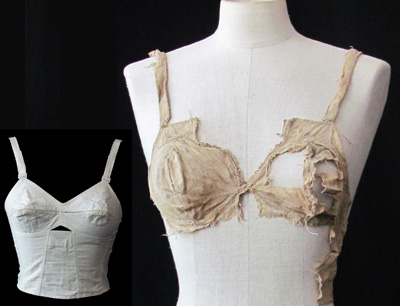Medieval lingerie discovered

In the course of extensive reconstruction of Lengberg Castle, East Tyrol, Austria, funded by the country Tyrol, starting July 2008, archaeological investigations of several parts of the building were carried out under the direction of Harald Stadler (Institute of Archaeologies, University of Innsbruck). During the research a vault filled with waste was detected in the south wing of the castle in room 2.07 on the 2nd floor. The fill consisted of dry material in different layers, among them organic material such as twigs and straw, but also worked wood, leather - mainly shoes - and textiles. The building history, as well as investigations on construction techniques performed by Martin Mittermaier and Walter Hauser (Landeskonservatorat Tirol) and the archaeological features heavily suggested a dating of the finds to the 15th century, when another level was added to the castle by order of Virgil von Graben. The reconstruction is mentioned by Paolo Santonino in his itinerary, who also gives us a short description of the castle and mentions the reconstruction and the consecration of the castle chapel by Pietro Carlo (1472–1513), Bishop of Caorle, on October 13th 1485. The vault spandrel was most likely filled with waste during the addition of the 2nd storey as isolation or to level the floor. This date has now been confirmed by fife Carbon-14 dates carried out at the ETH-Zürich.
The textiles
The assemblage consists more than 2.700 individual textile fragments. An initial review of the material gave a wealth of different forms, including a number of almost completely preserved pieces of clothing as well as fragments of linen lining of garments with remnants of the former colorful woolen outer layer.
Fragments of several linen shirts show pleats on collar and sleeves. The sleeves of these shirts with preserved textile buttons and corresponding button holes with small cuff circumfence suggest that they were constituents of female clothing, or were even worn by children. One pair of completely preserved linen underpants, the fragment of a second one and a textile fragment of red and blue wool which turned out to be the codpiece of a pair of trousers belong to male clothing.
The brassieres
Four linen textiles resemble modern time bras. The criterion for this classification is the presence of distinct cut cups. The two more fragmented specimens appear to be a combination of a bra and a short shirt. They end right below the breast but have additional cloth above the cups to cover the décolleté, and no sleeves. Both “bras” have decorated lower ends. Finger-loop-laces (laces worked in loop manipulating braiding technique) are sewn onto the hem with lace-stitches resulting in simple needle-lace. Besides its decorative function - one that cannot be seen anyway when worn under a dress - this also serves as reinforcement for the hem and adds further support to the breasts.
The third “bra” looks a lot more like modern bras with two broad shoulder straps and a possible back strap, not preserved but indicated by partially torn edges of the cups onto which it was attached. The knot in the shoulder straps is secondary. This “bra” is also the most elaborately decorated with needle-lace on the shoulder straps, sprang-work between the two cups and, like the two aforementioned “bras”, a finger-loop-lace and needle-lace at the lower end.
The fourth “bra” is the one that resembles a modern bra the most. At the first assessment this garment was referred to in German as “Mieder” (= corselette in English) by the excavating archaeologists. It can also be described with the term “longline bra”. The cups are each made from two pieces of linen sewn together vertically. The surrounding fabric of somewhat coarser linen extends down to the bottom of the ribcage with a row of six eyelets on the left side of the body for fastening with a lace. The corresponding row of eyelets is missing. Needle-lace is sewn onto the cups and the fabric above thus decorating the cleavage. In the triangular area between the two cups there might have been additional decoration, maybe another sprang-work.
Are the bras indeed from the 15th century?
There are considerable differences of opinion as to who 'invented' the brassiere or bra. Among those named is the French corset-maker Herminie Cadolle in the late 18th century and Mary Phelps Jacob who was awarded an US patent in 1914.
Up to now there was nothing to indicate the existence of bras with clearly visible cups before the 19th century. Medieval written sources are rather vague on the topic of female breast support, sometimes mentioning “bags for the breasts” or “shirts with bags”. Other sources only mention breast-bands to bind down oversized breasts.
As no comparable archaeological textiles of medieval “bras” were to be found, fiber samples of two bras were sent to the ETH (Eidgenössissche Technische Hochschule = Swiss Federal Institute of Technology) in Zürich to be Carbon-14 dated. In addition fiber samples of the pair of underpants and two other textiles were also radiocarbon-dated. All results confirmed the dating of the finds to the 15th century.
(Beatrix Nutz)